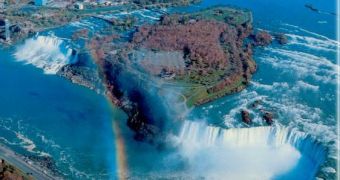Niagara Falls consists of a couple of massive waterfalls located on the Niagara River, forming the frontier between Ontario (Canada) and New York state (US). Niagara river, flowing northward, joins Lake Ontario and Lake Erie, being closer to Lake Ontario, and it's just 56 km (35 mi) long.
Niagara Falls comprises three separate waterfalls (one in Canada, the other two in the U.S.): the Canadian Horseshoe Falls (Canada), by far the most spectacular, the American Falls, and the smaller, adjacent Bridal Veil Falls. The waterfalls are found 17 mi (27 km) from the American city of Buffalo, New York and 75 mi (120 km) from Toronto.
Goat Island separates the Canadian Horseshoe Falls to the west from the American and Bridal Veil Falls to the east. While not exceptionally tall, Niagara is very wide. With over 6 million cubic feet (168,000 m?) of water falling over each minute, and almost 4 million cubic feet (110,000 m?) on average, it is the most powerful waterfall in North America.
The Canadian Horseshoe Falls drops about 170 feet (52 m), falling in a 55 m (183 ft) deep pool, while the American Falls has a clear drop of only 70 feet (21 m) before reaching a jumble of fallen rocks, deposited by a massive rock slide in 1954. The big Canadian Horseshoe Falls is about 2,600 feet (792 m) wide, while the American Falls is 1,060 feet (323 m) wide.
In the last 12,000 years Niagara retreated with about 11 km (6.8 mi), reaching its current placement. By 1678 the Canadian Horseshoe Falls had a straight line edge, while today it is U-shaped. Once the erosion rate of Niagara was of about one meter (3 ft) annually; now it is of about 36 cm (one foot 2) at 10 years.
The erosion of Niagara is due to the fact that the water falls from a high and hard dolomite sill onto a soft layer of sandstones and shales. When the lower layers bypass a certain erosion threshold, they fall down, and the fall further retreats.
Niagara is exploited for hydroenergy production, both by Canada and US: up to 4,200,000 kW, one of the highest values in the world. The water passes through turbines before reaching the falls.
After the shooting of the "Niagara" movie in 1953, the falls turned into a favorite wedding voyage of many couples. Excursions on boat for visiting the falls are made since 1848. Canadian tourists wear blue raincoats while the American tourists yellow ones. To see an overall image of Niagara, you can take the Spanish Cable Railway, founded in 1916, located 4.5 km (2.7 mi) upward from the falls, over a giant eddy.

 14 DAY TRIAL //
14 DAY TRIAL //